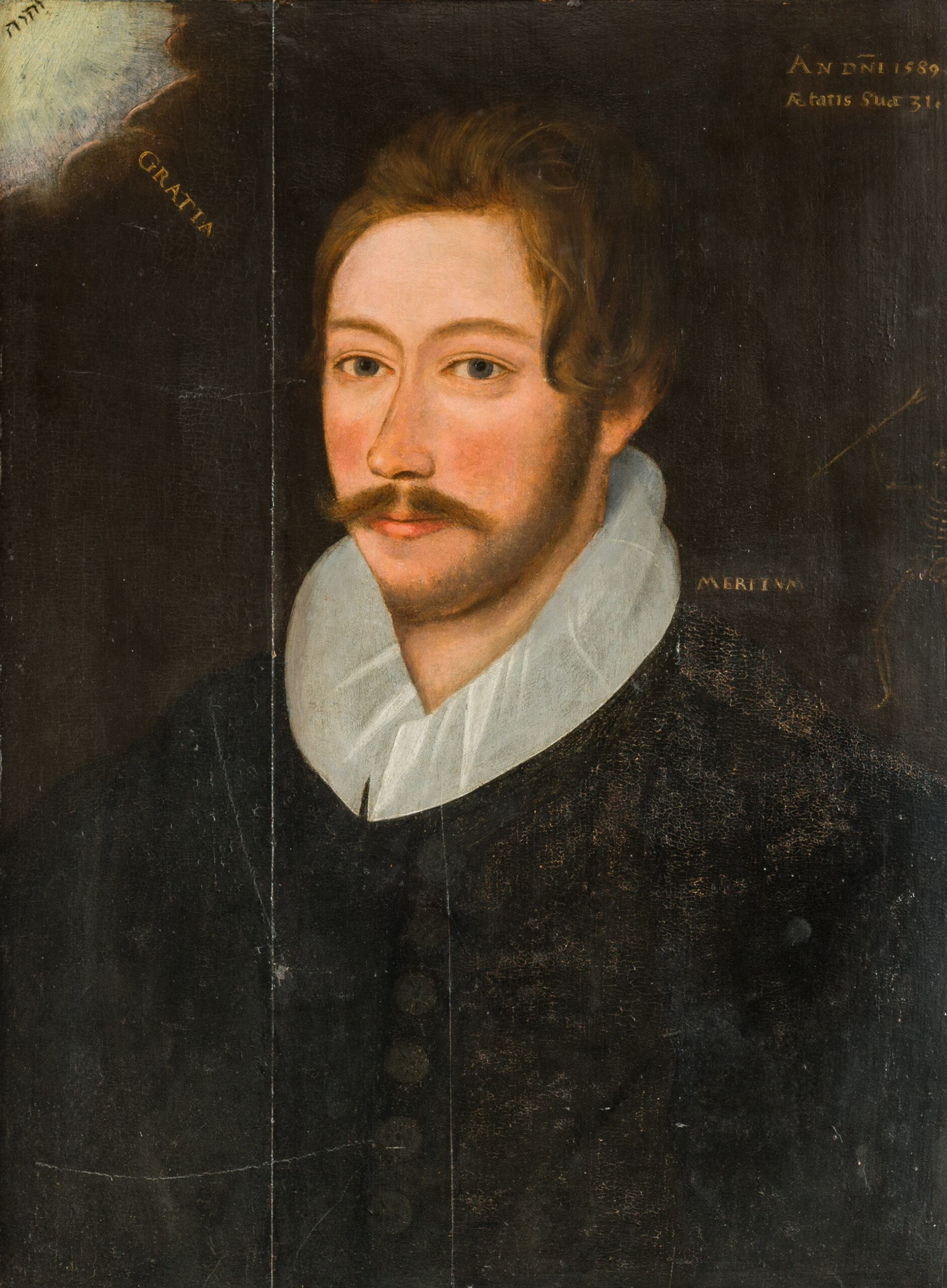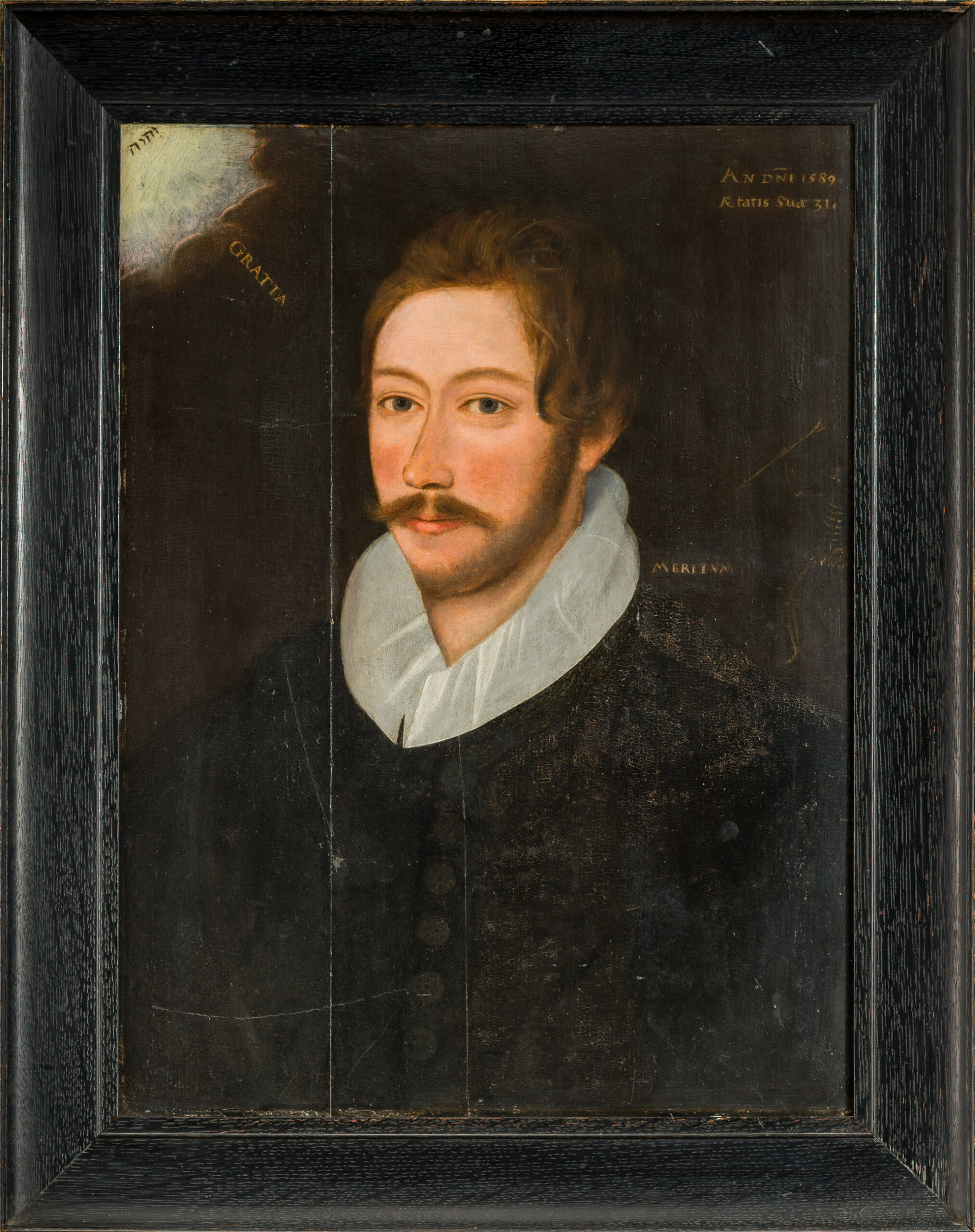Portrait of Gentleman
1589
England
W 18" (frame 22 3/4") × H 24" (frame 28 3/4")
Stock # Marh2364
SOLD
English school. Oil on oak panel.
This portrait depicts an English gentleman of the late-sixteenth century, dated AN DÑI 1589. The sitter who is portrayed has not as of yet been identified, though the emblems and inscriptions that are presented throughout the work offer an insight into the life of this gentleman.
The gentleman sits before a dark plain background and is presented in a rather linear manner with an almost naïve approach toward the pictorial space. His anti-naturalistic features are met with an intimacy of light, that highlights his hazy brown complexion whilst contrasting with his striking blue eyes. The sitter is attired in a black doublet with a button downed middle section and followed by a white ruff collar. The artist of this work is currently unknown, though it can be understood that this is by an early English school.
Signs and symbolism were an often essential feature of late Elizabethan portraiture. The inquisitive mind was eager to unravel these visual riddles and motifs that would allow for an esoteric image and motto. In the upper right corner of this portrait sits an inscription that provides the age of the sitter, Ætatis Suae 31, along with the date in which this piece was produced. Further inscriptions include יהוה presented on the light source in the upper left corner of the portrait. The placement of this word is positioned in a way that suggests a radiating sunbeam of light from the light source directed towards the sitter, suggesting that the word has religious connotations. The inscription roughly translates to ‘God’ in Hebrew and is known as a Tetragrammaton or Tetragram which is a four-letter word from the Hebrew bible. It was at the beginning of the sixteenth century when the Christian translations of the bible were being mass-produced, and these Hebrew inscriptions would largely be depicted in Northern-European historical paintings. The placement here is slightly unusual for this period in England, though it may be concluded that this inscription alludes to the sitter’s religious beliefs or his connection to Judaism. It may be important to note that this is a tentative attribution and it is unlikely to know the exact reasoning for this inclusion without knowing the identity of the sitter.
To the lower right of the portrait, we see another inscription the Latin word, ‘MERITUM’, which may be a Latin word used to allude to the memento mori that we see here in the form of a skeleton who points an arrow towards the sitter. This symbolic reference acts as a visual emblem of the reminder of death. The skeleton bears a striking resemblance to the reminder of death in the Allegory of Man, an example of 1570 (Fig 2). Whilst it has been noted by the art historian Roy Strong, as having “Erasmian overtones of the perfect Christian Knight” and that the composition is almost identical to Jodocus Hondius' Christian Knight Map of the World (Fig 3). Allegorical pictures such as these were known to have been Neverlandhsih in origin and appeared in the collections of Elizabethans in the sixteenth century.
It was fundamental for Tudor and Jacobean portraiture to serve as a type of recording for the sitter, whilst with the purpose of accentuating their status amongst society. As we see in the portrait at present, this gentleman wanted to record a moment in his life whilst at the age of 31. The visual riddles and motifs add to the excitement and complexities of English Tudor life and whilst with the modern eye's interpretation allow for a developing understanding of the portrait. Overall this portrait makes for an interesting interpretation of a sixteenth-century English gentleman, whilst radiating an abundance of Renaissance individualism.
INSCRIBED: At the top: AN DÑI 1589 and: Ætatis Suae 31
On either side of the head: יהוה (God) / GRATIA / MERITUM
COLLECTIONS: Private Collection UK
Literature: Artists of the Tudor Court: R., Strong & V. J. Murrell, The Portrait Miniature Rediscovered 1520-1620, Victoria. & Albert Museum (London: 1983).
R., Strong, English Icon: Elizabethan and Jacobean Portraiture, Routledge & Kegan Paul PLC (1969).

